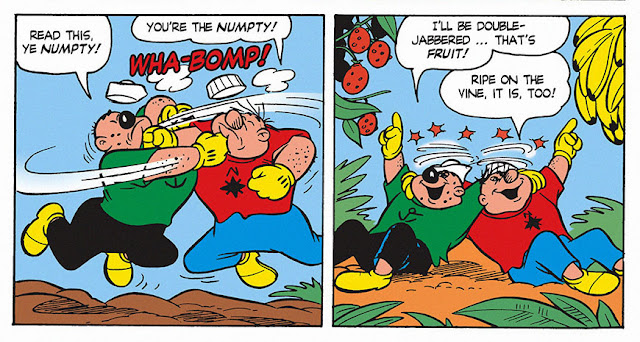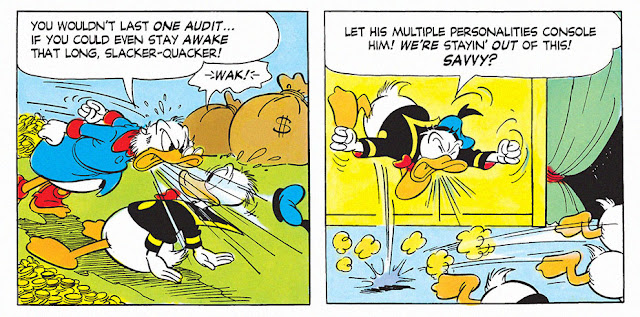I'm a bit late with this post, but I planned on doing a quick talk about all the Disney Masters volumes as I got around to read them. There's a lot of interesting things to note about the stories inside! I already did a post about the first two box sets in 2018, and here are some notes on the third box set, with volume five and six in the Disney Masters series.
As I wrote in the last post, the first two box sets had a 90th Anniversary sticker on the shrink wrap. The third box does not (at least not the one I received), but volume 5 has the same sticker on the cover. Online images of the book, including the one on Fantagraphics' own webpage have the logo on the cover, but it's actually just a sticker. Maybe later printings/distributions of the book will be different.
 |
| Screenshot from Fantagraphics' webpage, cover with the MM 90th Anniversary logo |
Volume 5 - Mickey Mouse: The Phantom Blot's Double Mystery (Romano Scarpa)
Volume 5 is another book with stories drawn by Romano Scarpa, starting with two classics and ending with a story seen in English for the first time.
The Phantom Blot's Double Mystery
This story already got an American printing in Gladstone's Mickey and Donald series. But there the story was altered to fit a 4-layer format, with extended art, a few things cut out and in 3 parts different from the original 4 parts. The Disney Masters book have the story in its original format.
 |
| Gladstone's version with extended art (left), and original version in Disney Masters (right) |
 |
| End of part one and start of part two in Gladstone's version |
 |
| Same pages in the original layout in the Disney Masters book |
The story could be seen as a sequel to Mickey Mouse Outwits the Phantom Blot, with the Blot trying to get revenge on Mickey and with several references to the original newspaper story.
 |
| Mickey and O'Hara refering to events in Mickey Mouse Outwits the Phantom Blot |
 |
| Same costume in Mickey Mouse Outwits the Phantom Blot (left) and The Phantom Blot's Double Mystery (right) |
While the story starts and ends as a Phantom Blot story, for quite a while it's mostly a Mickey+Eega story, when Eega Beeva suddenly appear.
But in this translation Eega calls the thnuckle-booh for Pflip. While originally and in a couple of other translations I checked, he is called Flip 2° (Flip the second), suggesting it's not the same Flip/Pflip as in the newspaper stories.
 |
| The name is Flip 2° in the original Italian text |
This one also has a nice feature turning him red when danger is around.
But I didn't think Eega would ever call him a dog…
 |
| From the newspaper story Mickey Makes a Killing, making it clear that it's not a dog! |
 |
| From The Phantom Blot's Double Mystery |
The translation in Disney Masters is the same as the earlier Gladstone version, with parts that was cut there added. But the dialogue has been adjusted here, and most notably the way Eega talks. The Gladstone dialogue has a P in front of almost everything he says, but this has been toned down in the new book. It's done in a way that still keeps the usual way of talking, but the text is a whole lot easier to read! Overusing the p-thing can get a bit annoying after a while.
 |
| Gladstone dialogue (left), Disney Masters dialogue (right) |
We also got a strange appearance of The Mad Hatter from Alice in Wonderland in this story, here named Thomas Topper.

The Last Balaboo
The Last Balaboo is the first story with Birgitta, a character created by Scarpa that is now part of the regular cast in Duckburg. As the title say we also get to meet the last Balaboo, which we just learned was not really the last one of his species at all. A few years ago we got The Next-To-Last Balaboo published in Europe as a sequel to The Last Balaboo.
The Last Balaboo is also previously published by Gladstone, but it's nice to have it collected in hardcover on proper paper. We also got a different coloring than used by Gladstone.
 |
| Coloring in Uncle Scrooge #242 (left) vs. Disney Masters vol.5 (right) |
The Eternal Flame of Kalhoa
While the two first stories in this book are classics, The Eternal Flame of Kalhoa is the most fun one in my opinion. And that credit goes to O'Bully and O'Gally, two Irish sailors who is constantly getting in fights with each other and making a havoc!
 |
| They are constantly fighting, but good friends again imedialty after |
According to some texts I've read about the story, it's based on an episode of the newspaper comic series Tim Tyler's Luck. But I haven't been able to find any copies of those comics to compare..
The story is also adapted to a book novel, illustrated with art from the comic story.
 |
| Book adapting the comic story |
 |
| Panel from the comic story (left) reused illustrating the novel (right) |
A lot of the early Italian Disney comics features guns and can be a bit violent compared to todays standard. When this story was first published in northern Europe in the 70's it was already censored back then with guns removed. The Disney Masters series try to publish the stories as close to the original as possible, and I didn't notice any obvious censoring here. But there might be minor cases like the bullets being removed (but not the gun) like I've seen in some other stories.
 |
| Norwegian 1st edition (left), later printing with coloring goof (middle), original panel as in Disney Masters (right) |
Volume 6 - Uncle Scrooge: King of the Golden River (Giovan Battista Carpi)
We haven't seen a lot of stories drawn by Carpi published in the USA, but we've had a few – maybe most notably The Diabolical Duck Avenger, with Duck Avengers debut. But Carpi was a productive creator and Europe has seen a large number of his Disney stories trough decades.
King of the Golden River
Carpi is known for drawing many of the literature parody stories with Disney characters, f.ex. Hamlet by William Shakespare and The Count of Monte Cristo by Alexandre Dumas.
 |
| Example from Carpi's Hamlet parody, printed in English in a British book |
The first story in this book is also based on a short story with the same name by John Ruskin, but maybe more inspired by than a parody story like the ones mentioned above.
The story is from a few years into Carpi's Disney production, but is a nice example of his early style. At the very end of the story we also get a little trivia. If you ever wondered how much the ducks weight, now you have the answer 😀
Mickey the Kid and Six-Shot Goofy
I briefly mentioned this story on the blog before, when talking about IDW's Showcase #2. Back then Mickey the Kid and Six-Shot Goofy was available digitally in English as Mickey Kid and Goofy Six-Shots on comiXology. But now we finally got the origin story on print! The earlier digital edition was actually removed for purchase on comiXology when this this version got published by Fantagraphics. The same thing happened with Mickey Mouse in the Delta Dimension, The Space Tourist (titled The Tourist at the End of the Universe by IDW) and The Factotum Cruise (titled The Bad-News Bruise Cruise by IDW). They also got removed from comiXology when a new translation was published by IDW/Fantagraphics. Maybe one of the reasons was to not get any focus on the different dialogue, but I'll post a little example here to show.
 |
| From the earlier digital edition (top) and the Disney Masters book (bottom) |
Me, Myself–And Why?
The book ends with another story with Scrooge, Donald and the boys. This one was first published in 1970 while the first story in the book is from 1961. But comparing the two, you can see that the drawing style has changed a lot.
 |
| From King of the Golden River (1961) |
 |
| From Me, Myself–And Why? (1970) |
Me, Myself–And Why? is a perfect example of what I've always thought of as "the Italian style" from the era. We have the usual overdramatic expressions and actions.
...the typical running all over the place with cloud dust.
And we even get the recurring joke as often seen in Italian stories where Scrooge go to Donald's house to eat food.
Also, if you ever need to explain to someone what it means to "have several hats on", you can just point them to this story. It's the perfect example! 😁
In the story we see a butler that looks different than the Quackmore we know from other Italian stories translated to English. The inducks database identify him as "Battista in Cimino scripts", and this could have been a good opportunity to give this butler a different English name. But on the other hand, if you check a bunch of other Cimino stories drawn by different artist you would find a lot of different looking butlers. So maybe it's best to not use any names for them to add to the confusion…
 |
| The butler in Me, Myself–And Why? |
This book didn't feature any stories written by Carpi, but he also wrote a lot of the stories he drew. I wouldn't mind seeing another book dedicated to him with some of those stories, maybe with Mickey the Kid vs. Jack the Streamer as a follow-up to this book and as a prequel to IDW's Showcase #2.












Some comments:
ReplyDelete* A few places online, including the Disney wiki, Edward Topper is listed as a name for The Mad Hatter. Anyone know the source for that name? It's not mentioned in the 1951 animated movie as far as I know (I checked a transcript of the movie). And it's not used in Lewis Carroll's original book.
* If anyone know what dates the Tim Tyler's Luck serial that inspired The Eternal Flame of Kalhoa was running in the newspapers – I'd love to know too! It would have been interesting to try to find.
* I tried to do some research on the whole “Battista in Cimino scripts” thing when writing this, but it ended with me being even more confused than I already was...